The discussed automatic change over relay circuit was requested by Mr.Karimulla Baig. The circuit normally charges the connected battery at constant current through the power received from the solar panel, and reverts to DC power from an AC/DC adapter in the absence of solar energy (during night time). Let's the read the request in more details:
Technical Specifications
Please help me in designing the change over circuit for my battery charger. where i want to charge my 6V 4.5Ah battery from solar and AC mains when ever there is no power from solar i need to charge my battery from AC mains.
i have made the both chargers of both AC mains charger and solar Charger and i need a change over for this kindly help me in designing the change over circuit.
The problem what I'm facing is there will be always voltage across the panel even though no current, I'm facing the problem to change it to mains.
Regards, Karimulla Baig"

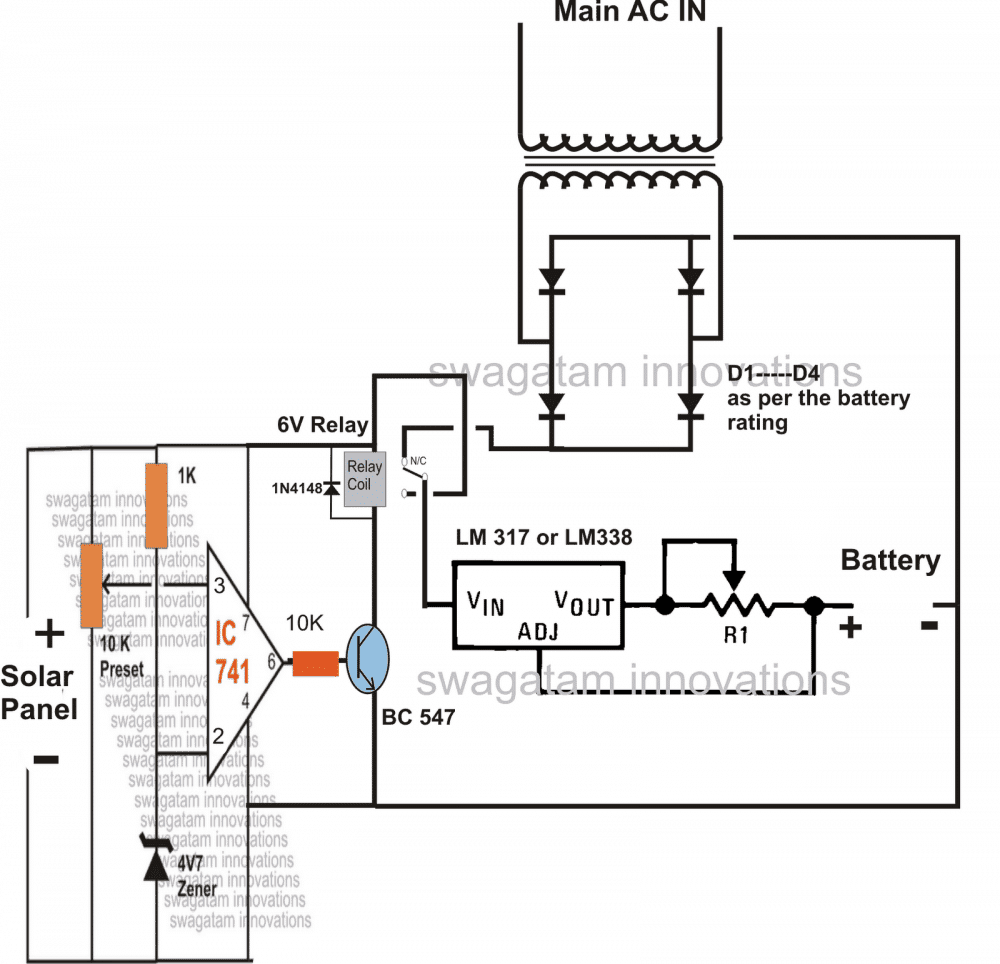
How the Circuit is Designed to Work
Looking at the proposed circuit diagram, we see three basic stages, on the left an IC 741 circuit, at the center a voltage regulator stage using IC LM317, while on the top an AC/DC adapter circuit.
The AC/DC adapter circuit is a simple rectified transformer power supply, designed for providing 7V DC as long as there's mains power available.
The IC317 circuit is a regulator circuit, configured for generating a constant current, 7 volts output to the 6V battery which is connected at the given points.
The pot with the LM317 IC may be adjusted to produce the required charging output for the particular battery.
The most important part of the circuit is the IC 741 stage, which is set up as a high voltage trigger circuit.
The associated preset is adjusted such that the relay activates when the solar panel voltage is above 7 volts.
The activation of the relay means the regulator circuit and the battery receive the voltage from the solar panel via the N/O contacts of the relay.
However, the moment the panel voltage drops below 7 volts, the relay switches OFF, connecting the DC adapter power with the regulator circuit, and now the battery starts getting charged through the AC/DC adapter voltage source.
The above results confirm perfect functioning of the entire circuit just as required by Mr. Baig.
R1 = Reference voltage/charging current = 1.25/Chg.Current
Solar Panel/Battery/Mains Changeover Relay Circuit
In this post I have explained a simple relay changeover circuit for managing a sustained power to the connected battery via a solar panel, and a mains operated SMPS power supply. The idea was requested by Ms Rina.
Technical Specifications
I would like to know how the circuit looks like for the problem that you have explained previously. But the application is little bit different.
There are three parameters:
The solar panel, The battery, And the AC/DC adapter. During day time the solar panel charges the battery and also stays connected to a 1hp air conditioner, pendaflour tube and a computer so that it can be lit through solar panel.
At night, all 3 appliances gets automatically connected to the battery.
And during overcast conditions or in absence of sunlight, if the battery voltage drops, the battery gets connected to the adapter so that it is able to get charged from the AC/DC source....
Thank you in advance Sir.
Rina
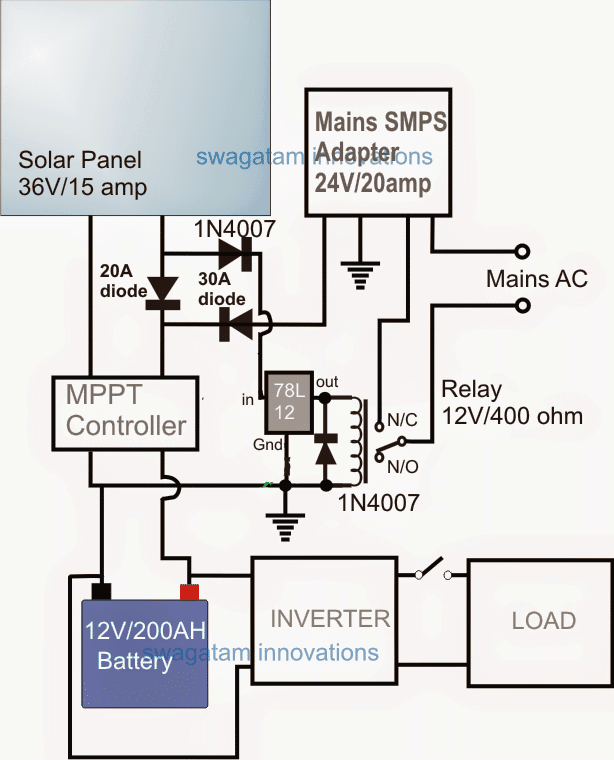
The Design
The proposed solar panel, battery and mains relay changeover circuit as shown above may be understood with the help of the following explanation:
Referring to the figure, we can see that the solar panel power is fed to a charger controller, preferably an MPPT circuit, and also to an SPDT relay coil (via a 78L12 voltage regulator)
This relay remains activated as long as the solar panel voltage is persistent during the day, and as soon as darkness falls, the relay contacts change over and switch the mains adapter voltage with the charger controller unit.
An inverter battery can be seen connected across the output of the charger controller, which is continuously charged through the controller either through the panel voltage or the Mains SMPS voltage, depending upon the day/night or overcast conditions.
The battery can also be seen directly and permanently connected to an associated inverter which is able to receive the battery power throughout the day and also during the night time.
However since the battery is consistently kept in the charging mode via the solar panel or the SMPS, its lower discharge level is never reached and the battery finds itself always in topped-up condition, and supplying a 24/7 power to the connected loads via the inverter output mains.
Solar Battery Charger, AC/DC Adapter Changeover
The enclosed circuit of an solar battery controller, AC/DC adapter automatic changeover circuit was requested by Mr.Juan. I have explained more about the request and the circuit from the below given discussions:
Discussing How to Build Solar Panel, DC Adapter Changeover Circuit
Hi Swagatam,
Your information and circuits are great.
But I want to ask for a special circuit.
I've a little solar panel with a solar/battery controller and a battery.
My load is connect to the load-pins of the controller, so when the battery voltage drops, the controller cuts off the output in load-pins immediately (from 11V-14V to 0V)
As hobby, I want to solar power from this system to a 12V led strip in my kitchen. But in case the light is on and the battery falls off, I want to autoswitch to a 220AC/12DC adapter that I have. So if my light is on, I will notice a little flick but nothing more, the light will be on all the time I want.
I don't want to "auto charge" battery with de AC/DC adapter in that case, because the main utility of my project is to use solar power.
I want to ask you several questions/circuits
1. I think I can't put together my controller ground and my AC/DC adapter ground, so I need a DPDT LATCH RELAY ("latch" in order not to waste lots of power from de battery system). And because of I can't put them together, I can't use the AC main switch of the kitchen to control all the system (I mean, the AC main switch of the kitchen will control the light, while the battery/controller powers the light either the AC/DC adapter)
2. What I want is that when my controller's load-pins output goes to 0V, the RELAY will turn to AC/DC power adapter. And when that output returns to 11-14V, the RELAY will turn to battery/controller system in order to waste "solar power" in my lights.
3. It doesn't mind if the relay is a single o dual coil, but the circuit has to be ultra low power consumption.
4. The ultra low power consumption is the reason for use a latch relay. It will only drain power when it has to activate o deactivate. I expect it not to activate never, so means that my solar system has a good battery capacity.
5. How can I control the light only with the AC main switch of the kitchen ?
Do I explain correctly ?
Before I knew about not to join grounds of the to systems (AC/DC adapter and controller output) I design this circuit with a simple SPDT normal relay. I have attached to you as a guide to understand this long post. but I suposse I can't do this way.
Hi Juan,
I am little confused, I couldn't understand the procedure correctly. There are three parameters:
The solar panel,
The battery,
And the AC/DC adapter.
I couldn't understand how you want to integrate these together.
According to me it should be like this:
During day time the solar panel charges the battery and also stays connected to the LED strip, so that it can be lit through solar panel.
At night, the LED strip gets automatically connected to the battery and uses the battery power for illumination.
And during overcast conditions or in absence of sunlight, if the battery voltage drops below 11v, the battery gets connected to the adapter so that it is able to get charged from the AC/DC source....
Is it that way you want??
First of all, thanks for your help.
Excuse me for my English.
The led strip is NOT always ON. It's a secondary light in my kitchen.
The solar panel is connected to a solar/charger/battery controller (it has 2 inputs and 1 output: solar panel, battery, and load).
The battery is also connected to the controller.
The load attached to the controller is the led strip.
What I want to do is give 2 power supplies to my led strip. The main supply is the one that comes from the controller (it's using solar power or a battery charged with solar power). The secondary supply is the one that comes from the AC/DC source.
I don't want to charge my battery with the AC/DC source (I've found some circuits for that).
I want to use the solar-battery-controller group to supply my led strip, but, just in case the controller cuts off the output (to protect the battery because of 3 or 4 four cloudy days or whatever), the led strip will be supplied by the AC/DC adapter.
Then, the next sunny day, the battery will be charged again with solar power (solar-battery-controller group).
I've to check the output of the controller, and when that output is 0V, I have to change to the AC/DC adapter. The battery remains "untouched".
There's also a handicap, the switch on the wall has to "control" the led strip (either supplied by controller, or by the ac/dc adaptor).(You will understand my previous post's pdf, the coil was energized by the AC/DC source, in order not to energized it if the wall switch is open)
NOTE: In future, I will also get a USB female in order to charge mobiles, and similar. (I've already get circuits to step down 12 V to 5 V). May be this USB female connector will have the same "AC/DC source as emergency" or not). but this doesn't matter now.
I got it now, the circuit will be very simple, I'll draw it and publish it in this blog as a new post, with the above discussions included....I'll inform you when it's posted....soon.
Thanks a lot,
Remember that is very important to drain a very "ultra low" power from the battery to make the circuit/relay/or whatever work. The solar system is little, so I can't have a constant drain of 30-50 mA, 24 hours per day. (that is because my first try was power the relay's coil directly with ac/dc source).
I will be using transistors instead of a relay, so the consumption will be negligible....
Done...here's the circuit requested by Mr.Juan, designed by me:
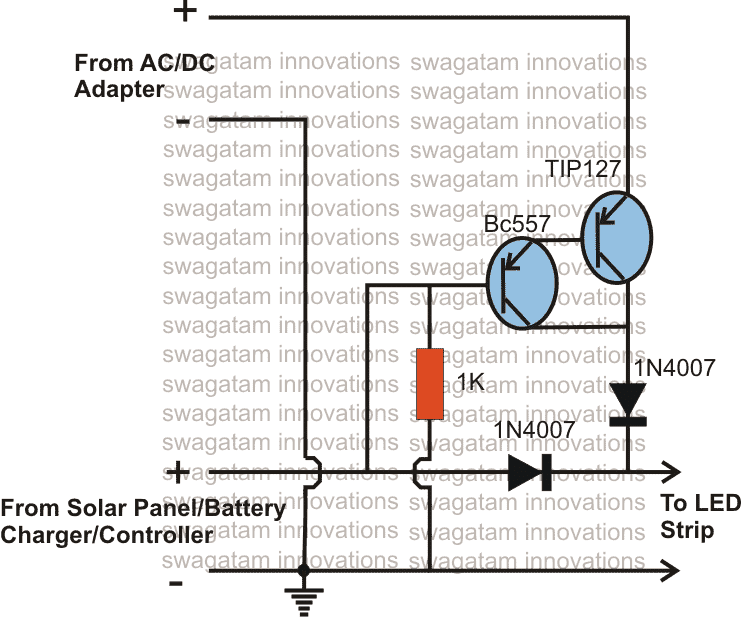
The following circuit goes in response to the added comment by Juan.
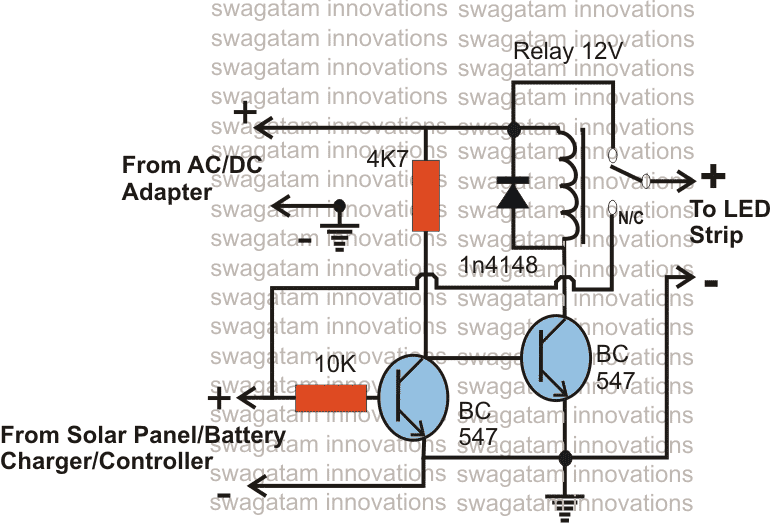
How the above circuits function:
In the upper circuit the transistor remains switched OFF by the +V from the solar panel during day, and switch ON during night via a the 1K resistor illuminating the LEDs. The diodes keep the voltages from the two sources isolated for correct functioning of the circuit
In the lower diagram, the left transistor conducts due to the presence of the solar voltage which grounds the base of the right transistor switching it off....during night the opposite takes place illuminating the LEds. The relay diode is a freewheeling diodes in order to protect the transistor from relay coil back emf.
the resistors are all 1/4 watt rated
For operating an AC load, the following design could be incorporated using a triac
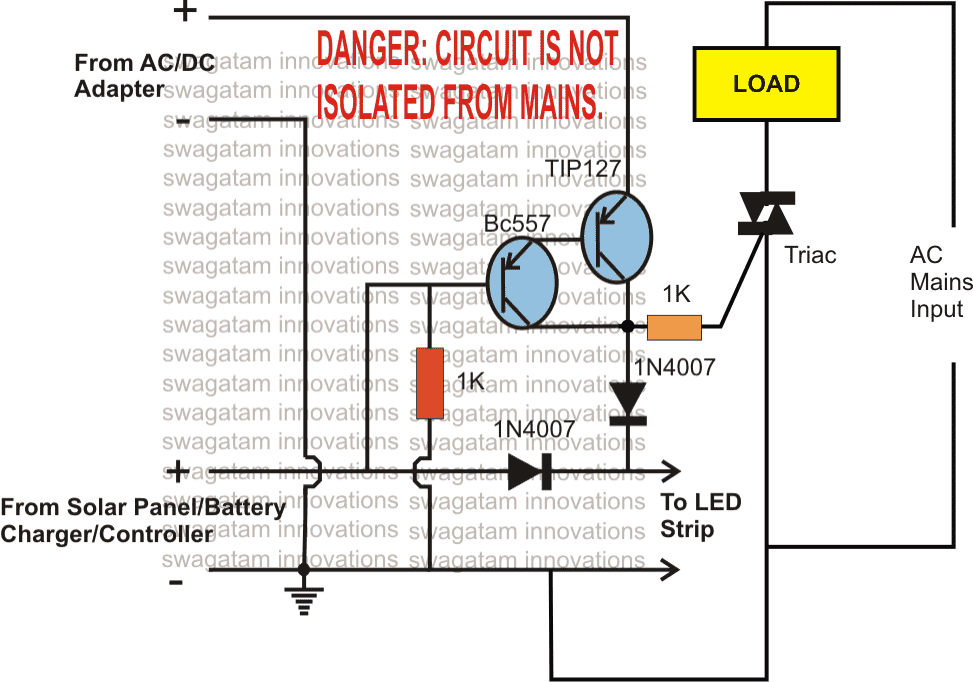

Have Questions? Please Leave a Comment. I have answered over 50,000. Kindly ensure the comments are related to the above topic.
I have a 120Wp solar pannel charging a 12 VDC battery bank of 140 Ah.
The load is allways requesting 2A up to 3A.
The MPTT box gets about 500 Wh/day into the battery and load in a sunny day.
How did i make it to not run out the battery and use the maximum Power from PV and feed the load with an Ac/DC psw without outages ?
Very Simple!
– connect MPTT to battery bank normally.
– connect a diode from PV to MPTT input.
– connect a diode from PSU to same MPTT input.
– adjust PSU output voltage to about 13.0 Volts (That regulates max discharge at night)
As soon PV increases output, the PSU decreases current till zero.
Solar pannel charges battery.
PSW limits the battery discharge but lets discharge to make Room for next day solar charge.
And more:
At the MPTT load output, Drive a relay to connect/disconnet load if any failure occurs with Power Bank.
Thank you for the valuable information!
Hi,
I am using the circuit with TIP127 and BC 557 as the automatic transfer switch to power my motor but the TIP127 is heating up when input from TIP127 is used while when input is given from the other input point then everything is fine.
Am I doing anything wrong in the circuit or it is normal?
I am trying to drive a motor and when driving from the first input the output is consuming more power than normal.
Hi, Which is the first input? and which is the second input? please name the inputs, so that I can understand the problem correctly?
Hi Swagatam,
You have mentioned in the second changeover circuit 20A and 30A diode. Could you please tell me in details. Apart from that what other’s diode can I use? Or can I use only normal rectifier diode 1N40007?
Hi Sayem, the 20 A diode rating will depend on the rating of the inverter current. It should be around two times the rating of the inverter current.
Hi Swagatam,
For 12 V battery 30 Ah which Solar Panel/Battery/Mains Changeover Relay Circuit I will implement? My Solar cut of points will be 11V and also want to implement Low and High charge protection.
Hi Sayem, for low high cut off circuit, you can apply the concepts explained in the following article:
Op amp Battery Charger Circuit with Auto Cut Off
Hi Swagatam,
Thanks for your reply. Could you please clear me one think for my 12V 30Ah battery—
1. Can I implement the second Changeover Relay Circuit with MPPT Controller which is described in this page?
2. Can I eliminate all the diode IN4007 and connect the 12V DC supply directly from the AC/DC adapter? Since I have a AC/DC adapter with 12V 10Am regulated power supply.
In a short for regulated AC/DC adapter and 12V 30Ah Solar battery what changes needs to be taken for that second Changeover Relay Circuit?
Hi Sayem,
Yes you can use the second changeover circuit.
All the shown diodes must be included to ensure proper isolation and working of the various voltage source stages.
Hi Swagatam,
Thanks once again for your prompt response. Could you please provide me the PCB Layout Design of the second changeover circuit.
Thank you Sayem, there are hardly any components in the design, just a few diodes, and a relay, so I think a PCB designer would do it quickly without charging anything for the designing…
can you please provide me the design of a solar Inverter which is used to drive a load of 1kVA. Please explain about the required battery rating.Also explain me about charging the battery from AC mains when required voltage is not available from the solar panels. Can you please show me the required circuit diagram for fulfilling all this purpose.
Dear swagatamji,
I am a avid follower of your blogs and have admire since long how you solve the problems with ease.
I was interested in electronics since childhood, but as the luck good have it, I became a doctor but my interest in electronics continues.
I have installed 6000 watt solar panel, attached to a 10 KVA inverter with 15 batteries ( 180volts) for my hospital.
Initially I had the problems switching between mains power from grid and solar power panel. Later on I used LDR to control changing relay between mains to s o l a r. the LDR was placed in such a way that it used to sense when it was sunrise and it used to to switch the inverter power supply from mains to solar.
But now I have an existing problem.sometimes it’s so happens that due to load or during rainy season the battery is fully discharged. I have tried using commercially available battery level indicator to trigger the LDR which will in turn changes the power input from solar to grid but I have not been successful. so can you design a circuit for me, in which when once the the voltage of a battery goes below a certain level say 11.4v then it should trigger a relay which would change the the power supply from solar panel to power grid, thus preventing deep discharge of the battery.Preferably it should be for 180 volt dc but if it is not possible then even a 12 volt circuit will solve my purpose
Thanks in advance
Dr Chandan Parashar
Dear Chandan ji,
It’s my pleasure, glad to have you to in my website!
You can try the last circuit from the following article:
https://www.homemade-circuits.com/low-battery-indicator-circuit-using-two/
But a 12V is recommended for this circuit. It can be modified for 180V also but might require some thinking. I can do it for you if to wish to have it.
However the circuit will oscillate between, say for example, 11V and 12V if 11V is selected as the low threshold per battery. Meaning once the relay cuts off the battery at 11V, the battery voltage will slowly begin rising, and when it reaches it 12V, the relay will switch back again, until the battery again drops to 11V, and this will continue. To avoid this you will have to experiment with a resistor value across the collector of BC557 and the base of center BC547. You can begin with a 33K and see by how much the gap increases between the low cut off and the upper restoration point.
Thanks a ton for prompt response.
I will make it and let you know
No problem, glad to help!
hello Godson l love to be like u am requesting to teach me
Hello sir Swagatam,
Thanks a lot for this post. I want to apply this schematic to my inveter to achieve the same purpose that it was designed for. But in my own inverter design, the main inverter transformer is the same one that is used to charge the batteries through the MOSFETs, meaning that there is no separate transformer for charging the batteries. How can I utilize this schematic to achieve the same purpose?
Also, if the batteries being used in the inverter has a total of 800Ahr or more, what relay will be suitable to handle such changeover?
Hello Godson,
you can replace the transformer wire connections to bridge rectifier as shown in the diagram with your inverter transformer’s charger output.
for handling 90 amp current you can replace the relay with a 100 amp relay, and also upgrade the driver transistor with a TIP122
One of your 12volts dc 1kv reliable circuit design for this transformer which is 5kv transformer to achieve a 5kv inverter, and more than one battery as many as possible could be connected in parallel as increase the dc input current as the voltage will remain 12 volts in other to achieve long service time of the inverter.
Thanks as i hope to see your repply soonest.
Regards.
5000/12 = 416 amps, with this much current the cable will need to be 1 inch in diameter and the inverter could take the shape of a huge box
Ok Mr swagatam my sugestion and idea goes this way: can we try to achieve from 2kv to 5kv inverter that will only use one 12 volts dc supply the sircuit, as i see in all your circuit designed each one above 1kv have dc supply of more than one battery acording to their wattage so wount it be possible to use only one 12 volts de supply to achieve 5kv ac output, am asking because i am aware of transformer of 5kv 230v in and 12 volts out, this transformer is locally made.
So how can it be when one can use one of your
Ok mr swagatam
I have a question to you which goes this way:
Is there not a way that one battery of 12 volts dc can be use to supply and be soficient for a circuit of 1kv inverter ciruit of your design to a step down transformer of 5kv 230 in to 12 volts out if use for inverter to be revice the transformer as 12 volts in and 230 volts out to acheive a 5kv 12 volts dc supply to 230 volts ac supply.
Note that this transformer is a local made which i know that i do very well and can give small details of it.
Pls sir go through it as i will wat for repply.
Thanks for your good work.
Zeal, it's possible, however to get 5kv from a 12V supply would call for a impracticable amount of current, that's the reason why voltage must be increased so that the current can be kept within feasible limits.
Tejas, I don't remember, please check it by using the search box above…
Sir have you designed circuit for above query… Please inform me…
sir can this circuit work with 40v,400w solar panel, and 40v ac to dc for charging of 36v 200ah battery? moreso, sir kindly post me ac-ac automatic changeover circuit that is when there no main power supply the circuit change to inverter and vice versal. Thanks.
you can try the following design:
https://www.homemade-circuits.com/2012/09/automatic-inverter-supply-and-mains.html
Dear Sir
I am using 2 pcs of 100W 18V Solar Panel connecting in series providing a 36V charging voltage to my 2 pcs 24V 40AH batteries connecting in series as well.
With this 24V battery; I am using a 24V 900W inverter to power my water features AC pumps unit only running in the day.
Can i use the above circuit for switching AC charging to the batteries in the night or batteries when the battery voltage is low.
My only worries is the components ratings in the circuit as my voltage should be in the 20s.
Thank you and Best Regards
Eric Woo
munkai@gmail.com
Dear ERic, you can surely use the above circuit for your purpose, however only after doing the following changes:
replace:
10k preset with a 22k preset
IC 741 with LM358
LM338 with LM196
Also use a 24V relay if 24v batteries are used, the transformer adapter will also need to be changed with a 24V DC adapter
……the zener resistor must be also changed with a 10k resistor.
Thank you very much… will try it out.
Regards
Eric
dear sir,
please give me circuit, and componenent list for 12 v battery
sir,
please give me detail circuit , component for 12v battery
Iam using 500w, 25Amps (100Wx5,5Amps each panel ) solar panel
with sine wave ups for charging
purpose,how to use your circuit for changeover to ac mains and
solar panel charger, i want to use day time with
sunlight only charge from solar panel and evening without
sunlight it will automatically change to ac mains sir plea replay battery 12v 150ah and mppt circuit inbuilt
Iam using 500w, 25Amps (100Wx5,5Amps each panel ) solar panel
with sine wave ups for charging
purpose,how to use your circuit for changeover to ac mains and
solar panel charger, i want to use day time with
sunlight only charge from solar panel and evening without
sunlight it will automatically change to ac mains sir plea replay battery 12v 150ah and mppt circuit inbuilt
You can try the following circuit:
https://www.homemade-circuits.com/2012/09/automatic-inverter-supply-and-mains.html